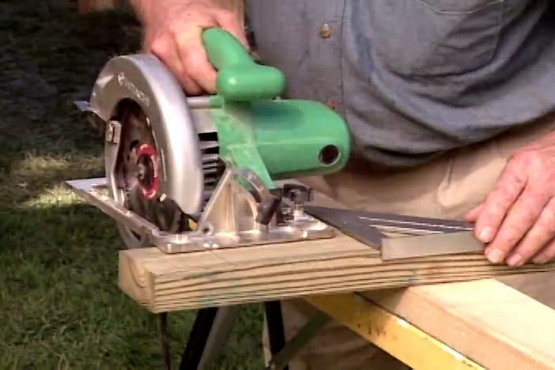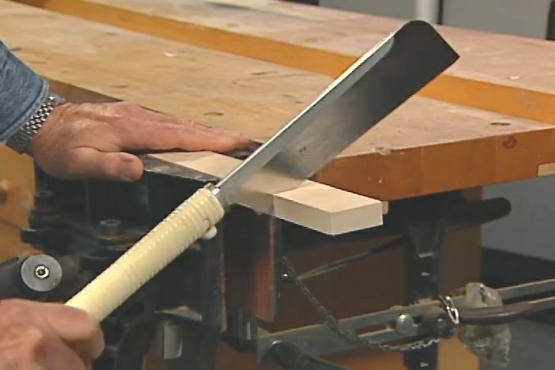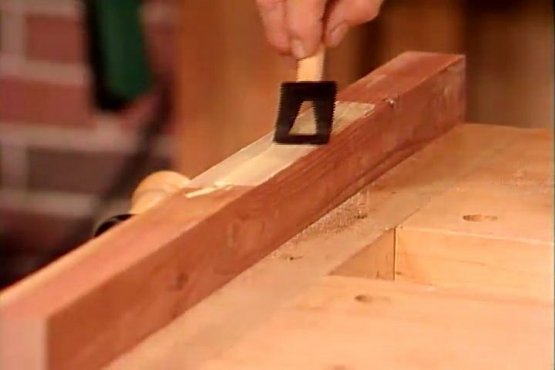RON HAZELTON:
Well our old kitchen door has served us well. But it is a wooden door and that means that in the summertime when the humidity rises, it swells or expands and can be kind of difficult to open. In the wintertime it shrinks or gets smaller and that has created drafts around the edge of the door. So what I'm going to do is replace it with a new state of the art insulated door. And I think the new door is going to work well enough so I may be able to eliminate my storm door.
Well the first thing I'm going to do is take down the old kitchen door and that means removing this hinge pin right here. Now I'll admit in the past, I have used a screwdriver to do that. By putting the tip right up here and hammering on the end.
But you know what, a screwdriver is not a striking tool and using it that way can really damage it. So I’m going to use this instead. Now this is a standard cold chisel. I've made a slight modification on a belt sander I've kind of grounded a little bit right here.
So that instead of having a blunt edge like this, it's got a rather sharp edge. That's going to allow me to get a good grip on the edge of that pin right there and drive it up, just like this. I remove the remaining pins and lift off the door, cutting through the caulk around the edge of the casing and at the joints to let me pry off the trim without damaging either the wood or the wall.
Driving the tapered cold chisen between the casing and the jamb gently wedges the 2 pieces apart. And gives me the space I need to insert a pry bar. Outside I remove the screws that hold the storm door in place. Then lift it off.
Then I tackle the outside trim in much the same way as the interior casing. Now the casing is off both on the outside and on the inside and the only things that's holding this frame in place right now are some nails, probably 3 or 4 on each side.
I'm going to cut through those using this reciprocating saw.
[SOUNDS OF SAW]
Goodbye old doorframe. A replacement door like the one I'm putting in here shouldn't require too many changes to the opening. But I am going to have to make a couple of modifications.
One is, I'm going to have to cut back the flooring about a half an inch here because the threshold on the door that I'm putting in is slightly wider than the door that I took out. So I'll do that. I'm using a circular saw.
I've set my blade depth just to cut through the material I want to remove here.
[MUSIC]
Now this strip came out of here nice and cleanly. I just have to make one other modification and that's to put this piece of half-inch plywood down here. It's going to act as a shim. That will help bring the bottom of the door up closer to the surface of the floor here. Now I want to check this to make sure that it's level in two directions.
It's pretty good in this direction. Maybe just a tad low on that end. Let me check it this way. Ah, this way it's not so good. It's kind of tipping toward the outside. So what I'm going to have to do here is put some shims in.
Starting down at this end. Let's try that okay. Pretty good. I place shims every 6 or 8 inches and nail them in place. Then trim off the excess with a Japanese handsaw. Next, I put adhesive backed aluminum tape on top of the sill to act as a moisture barrier.
Then install a new piece of wood trim. The new door I'm putting in is made of composite fiberglass with a polystyrene core that will insulate against summer heat and winter cold up to 5 times better than a standard wood door, helping to keep the house comfortable year round.
To insure water-tight seal around the edges, I apply sealant to the door sill and to the nailing flange on the doorframe. The whole idea here is just to tip this up into the opening. So that that seal that I put on the bottom doesn't get smeared around.
With the door up, I nail through only the top corners of the flange. Before I go any further, I need to step inside and check things out. Looks pretty good. Now there are 3 things that I want to check for. First of all, I want to make certain that the frame is square.
And I'm going to do that by measuring the 2 diagonals and comparing the numbers. If it's square, they should be the same. Okay this one is 87. And this one - and that's also 87, so we're in good shape here. Now the next thing I want to do is check to make sure that the sides of the doorframe are vertical.
or plumb. And I'm going to in this case, put the level on the hinges. That's right on. Now the last thing I want to check for is the margin. That is the gap between the door and the edge of the frame. It should be uniform - the same width or thickness. And in this case, looking real good.
Next, I insert shims between the doorjamb and the framing. The idea here is to make sure the sides of the doorframe are perfectly straight. Nails driven through the shims will make sure the jambs stay that way.
Finally, I trim off the excess. Well I've checked the measurements on the inside. Everything is square and plumb. And we've installed our shims. Now I can go ahead and finish nailing off this flange. To further seal the sides of the frame on the exterior, I apply more aluminum tape on top of the nailing flange.
There's hardly a project that I start that doesn't require an unplanned trip to the home improvement center. This time I've got to pick up some wood for the outside trim. I'm gluing together, 2 pieces of wood. A rectangular section and a drip cap to make the top trim.
The drip cap will divert water away from the door opening and prevent moisture from getting inside the frame. Just as I finish nailing, I hear a tiny voice behind me. What, what is it honey? You want to go bike riding? Here, let me put your helmet on.
Okay, I have to take a little break here, okay. Here, put your helmet on. I'll take a little break so you can do some bike riding. Yeah, we’ve got to get our priorities straight here, right. Let me see. Look at daddy. You know what?
I haven't had my good morning kiss yet. Can I have a good morning kiss? [MAKES KISSING SOUND]. Be careful. Well now that the really important business is taken care, I can nail up the side trim. The final thing to do out here is to apply sealant around the edges and tool off the excess with my finger.
Well except for a bit of paint, that finishes up things here on the outside. I'm going to step inside now and start on the casing. I insert some fiberglass insulation around the frame. Then it's time to put up the trim. Now the original came off in good shape.
So I'm going to reuse it. I'm also reusing the flooring transition strip that I took off before I removed the old door. Good pry bar and patience are what make this kind of recycling possible. One of the beauties of a good quality pre hung door like this is that the hardware borings and mortises are already done.
All I have to do is slip the lockset parts into place.
[MUSIC]
Ah, there's nothing like the sound of a finely crafted door. And you know what? This door is going to work just as well in the heat of summer as it will in the cold of winter.
And because it's insulated, I don't have to have my storm door out here. I'd say I've got the best of both worlds.














